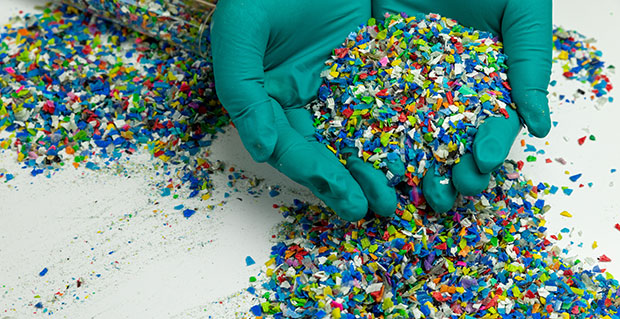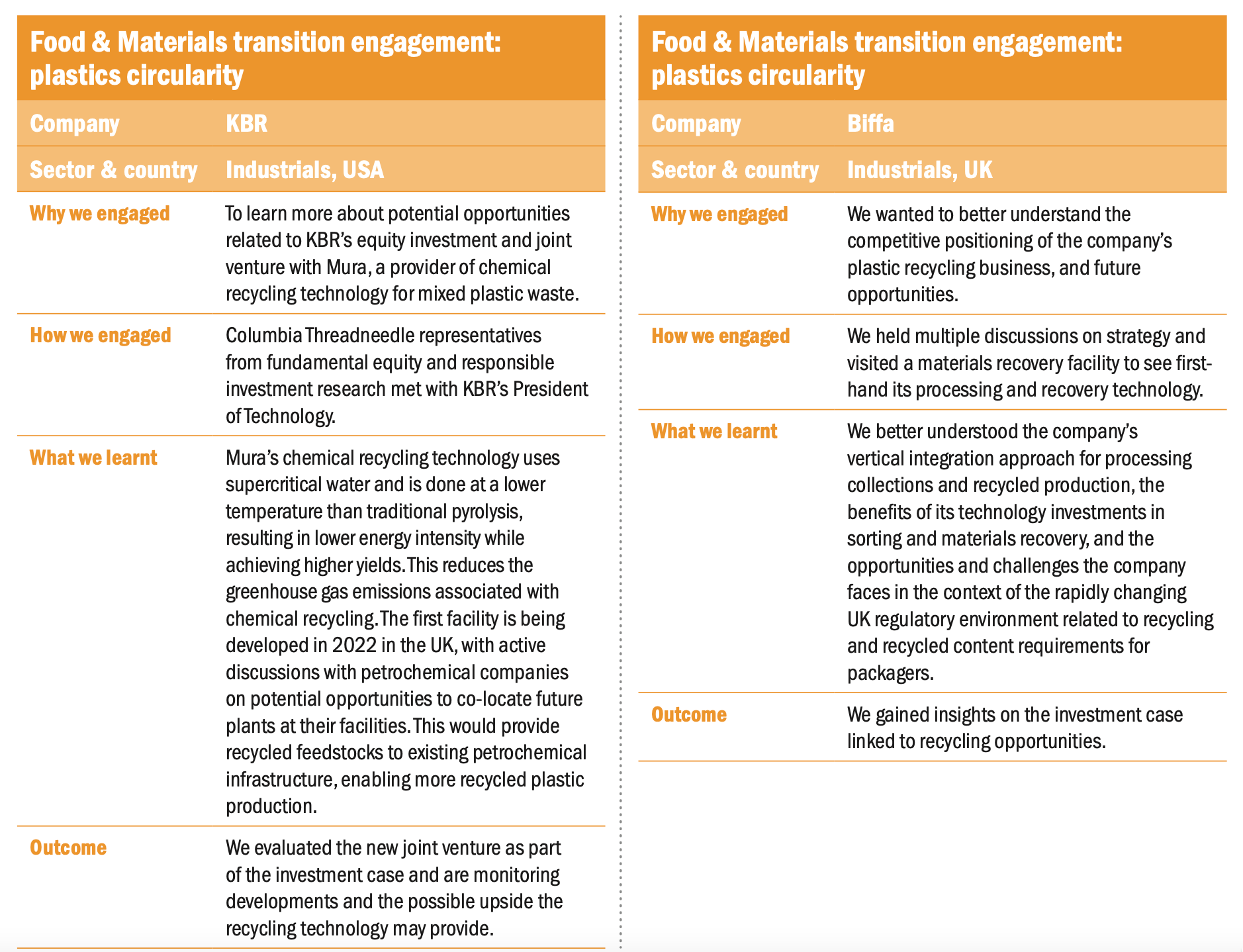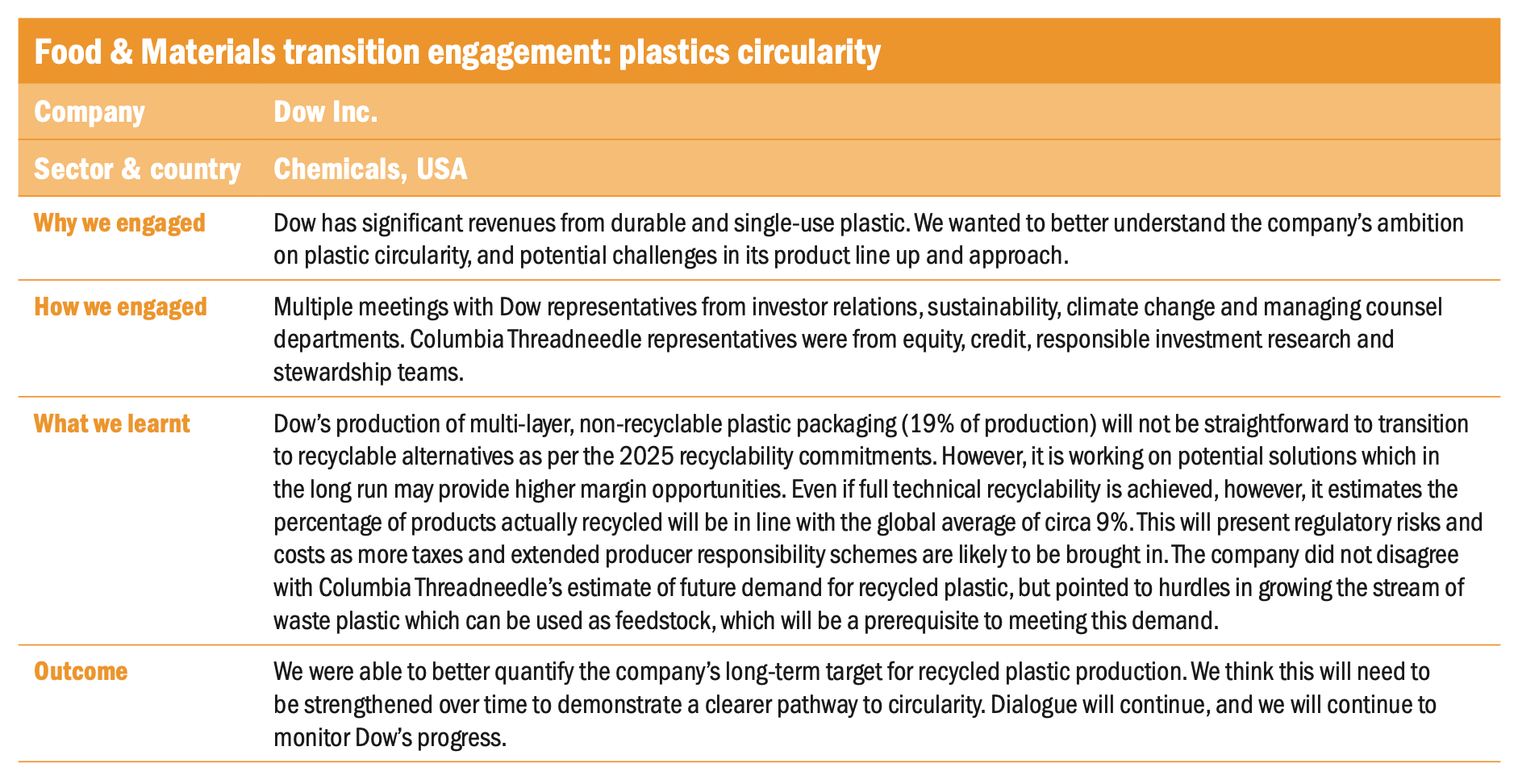Columbia Threadneedle - A circular transition for plastics
This growing environmental problem is increasingly a focal point for policy at national and international level.

Plastics are a growing environmental problem and increasingly a focal point for policy at national and international level. In recent months, the UN has agreed to develop a global treaty on plastics which could include cuts in virgin plastic production, as well as increasing collection and recycling infrastructure. At a national level, in April the UK implemented a plastics tax which will apply charges of £200 a tonne to plastic packaging that contains less than 30% recycled plastic.
Plastic pollution is also increasingly recognised as interdependent with other environmental themes.
For example, the draft text for the upcoming UN COP (Conference of the Parties) on biodiversity includes a goal to “eliminate loss of plastic waste” as part of the 2030 global biodiversity framework. In the context of net-zero goals, NGOs and stakeholders also continue to draw attention to the contribution of plastic production, use, waste and recycling to global greenhouse gas (GHG) emissions.
We expect these drivers will continue to create momentum towards a transition to more circular plastics. This will include: reducing the use of virgin plastics; increasing the use of recycled plastics and alternative materials; creating different product delivery models; and scaling up plastic collection infrastructure and recycling technologies. Following earlier research we undertook on consumer goods and packagers, we expanded our focus to plastic producers and waste companies via a roundtable with fundamental equity and credit analysts to discuss the risks and opportunities of these developments.
Plastic producers
Most plastics are produced by a handful of global petrochemical companies. The development of the industry has provided benefits to society via improving food preservation and introducing lightweight products, among other things, but in doing so it has also introduced a reliance on low-cost virgin plastic into everyday life for people around the world through our clothing, cars, electronics and food packaging – with much of this material ultimately destined to become waste.
Plastic producers now find themselves at the early stages of a structural shift that will increase demand for recycled plastic – most notably for single-use packaging, but also for more durable products – as companies such as Renault, LG, Vestas, Inditex, Adidas and many others establish targets for the use of recycled plastic. These are in addition to the regulatory requirements and pledges already made by consumer goods and packaging companies around increasing the use of recycled plastic by 2025.
Taken together, our analysis of corporate targets across sectors suggests that recycled plastic could account for up to 8% of plastics demand by 2025, and up to 15% of global demand by 2030. In this scenario, demand growth for virgin plastic could shift from the GDP+ growth rates previously seen to less than 1.7%. Currently, however, recycled plastic production is not sufficient to meet this demand, and chemical recycling technologies, which could increase volumes of material, are unlikely to do so before the latter half of this decade, based on capacity announcements made to-date.
In this context, a shift of this scale will require big changes for plastic producers. Companies that will be most resilient to these changes are likely to be those that have well developed circular strategies, as well as other advantages including: lower revenue dependence on non-recyclable plastic; a strategy and related targets for recycled production that is meaningful relative to the company’s production volumes; evidence of multiple partnerships and efforts to pilot and scale new technologies, such as chemical recycling, that can enable the company to adapt and nimbly respond to technical or other challenges; the ability to maintain and grow customer relationships through the transition, by working with customers to develop new and possibly higher-value products and forms of packaging; and access to low- cost virgin plastic feedstocks that will remain economically competitive in a scenario of slowing demand growth for virgin plastic.
Our analysis of several plastic producers against these criteria shows a mixed picture, with companies’ plans for increasing recycled production accounting for anywhere between 1% and 22% of their estimated 2030 production. The range and depth of company partnerships in relation to new technologies such as chemical recycling also varies significantly.
Waste and recycling
This shift to recycled plastic will also present big changes for the waste and recycling sector. The landscape of risks and opportunities across countries is variable given the different degree of recycling infrastructure, public education and collection rates. However, with rapidly growing regulatory changes and demand for recycled plastic, waste companies that are well positioned can reap the benefit of investment in new technologies, including advanced sorting technologies that can increase automation in facilities and recovery rates for materials, capturing the most value from waste plastic. Some waste companies may also benefit where they have opportunities to vertically integrate, increasing the degree of recycling and processing carried out on plastic collections.
To match increased demand, however, the scale of investments required will be vast: including improved collection and processing infrastructure, not just in developed markets with low recovery rates (for example the US), but in emerging markets with less developed infrastructure. As with plastic producers, a review of companies’ capital expenditure plans and future targets for increasing material recovery provides an indication of their plans and positioning for this transition.
Conclusion
Our analysis concluded with the recognition that there is a need for ongoing monitoring given the rapid developments on this theme. Continued research, collaboration and engagement across the fundamental and responsible investment thematic teams will help us to identify possible winners and losers and to encourage companies to continue to develop their circularity strategies.


Download 'A circular transition for plastics' pdf.
** Columbia Threadneedle analysis of company disclosures. Plastic volumes by end use derived from Geyer, et al, 2017.
Important information
For use by professional clients and/or equivalent investor types in your jurisdiction (not to be used with or passed on to retail clients). This is an advertising document. This document is intended for informational purposes only and should not be considered representative of any particular investment. This should not be considered an offer or solicitation to buy or sell any securities or other financial instruments, or to provide investment advice or services.
Investing involves risk including the risk of loss of principal. Your capital is at risk. Market risk may affect a single issuer, sector of the economy, industry or the market as a whole. The value of investments is not guaranteed, and therefore an investor may not get back the amount invested. International investing involves certain risks and volatility due to potential political, economic or currency fluctuations and different financial and accounting standards. Risks are enhanced for emerging market issuers.
The securities included herein are for illustrative purposes only, subject to change and should not be construed as a recommendation to buy or sell. Securities discussed may or may not prove profitable. The views expressed are as of the date given, may change as market or other conditions change and may differ from views expressed by other Columbia Threadneedle Investments (Columbia Threadneedle) associates or affiliates. Actual investments or investment decisions made by Columbia Threadneedle and its affiliates, whether for its own account or on behalf of clients, may not necessarily reflect the views expressed. This information is not intended to provide investment advice and does not take into consideration individual investor circumstances. Investment decisions should always be made based on an investor’s specific financial needs, objectives, goals, time horizon and risk tolerance. Asset classes described may not be appropriate for all investors. Past performance does not guarantee future results, and no forecast should be considered a guarantee either.
Information and opinions provided by third parties have been obtained from sources believed to be reliable, but accuracy and completeness cannot be guaranteed. This is an advertising document. This document and its contents have not been reviewed by any regulatory authority.
